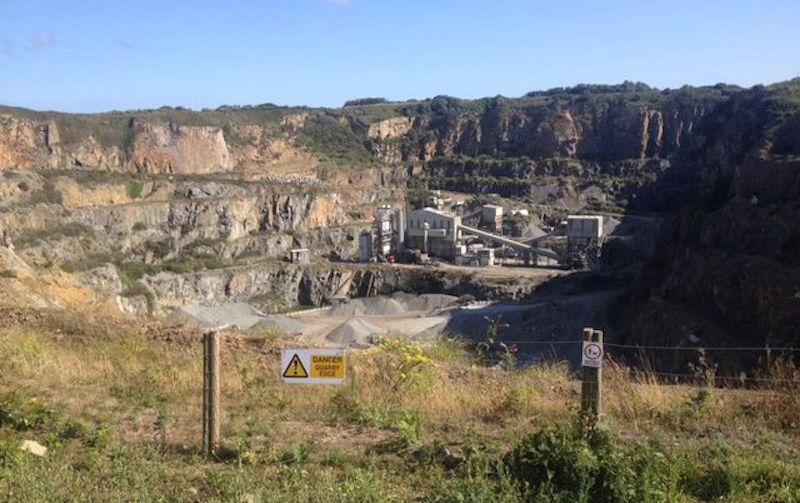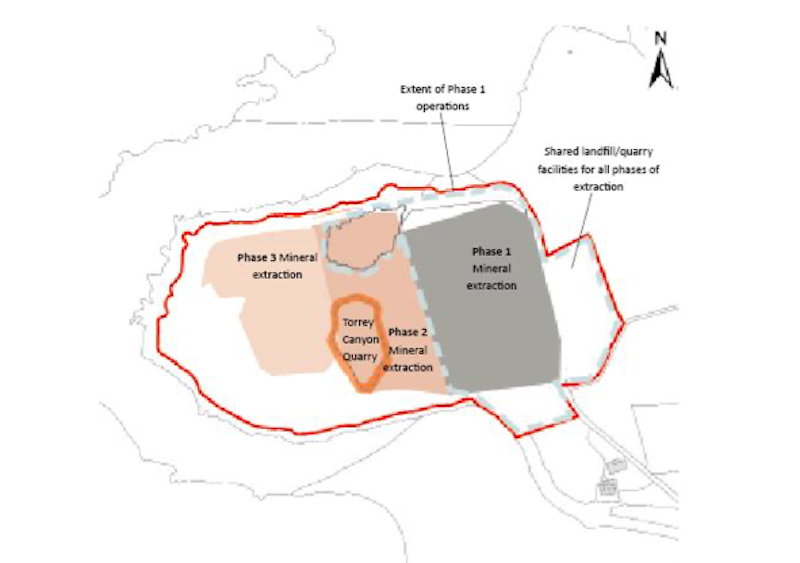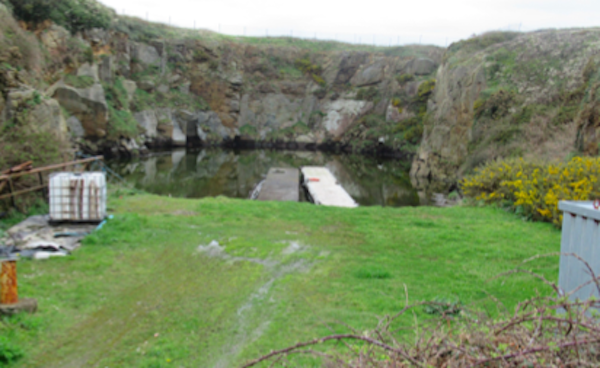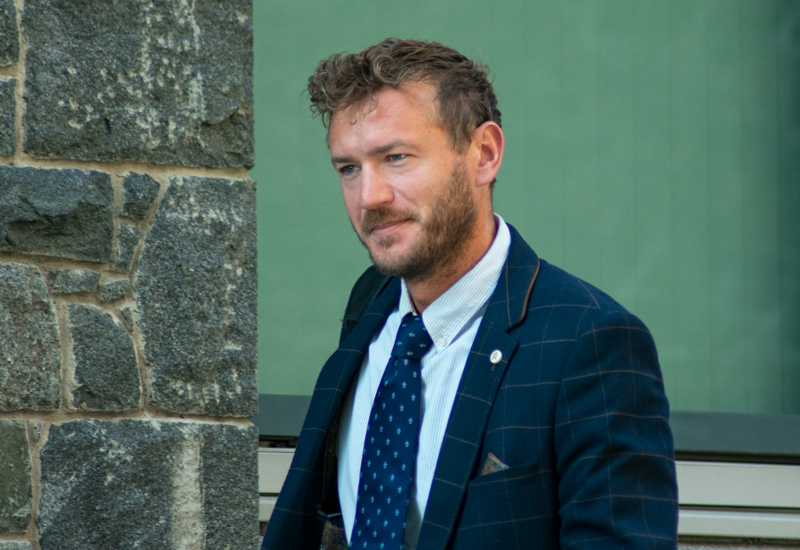


Chouet was first identified as a mineral rich site for extraction in the 1980s. 40 years later, Ronez is seeking the final approvals necessary to start quarrying the four million tonnes of reserves that lie beneath the Headland.
Politicians have endorsed plans to continue quarrying in Guernsey once reserves at Les Vardes are depleted in the next few years. It will prolong the finite lifespan of an industry that has been prevalent in the island since the 18th Century.
At its peak in the 19th Century, Guernsey’s granite trade was booming, with over 250 active quarries. Their natural reserves have, over time, been exhausted and today there is only one active quarry on Guernsey – Ronez current base of operations, Les Vardes.
The origins of the quarry date back around 200 years. It was operated during World War II and abandoned afterwards. It then re-opened in 1961 and has been in use ever since.

Pictured: Production at Les Vardes Quarry works granite deposits from the Bordeaux Northern Diorite formation to produce a range of aggregate products.
The base aggregate demand for the Island is met from the quarry, which works granite deposits from the Bordeaux Northern Diorite formation to produce a range of products which are supplied to the local construction market, either as ‘dry stone’, or used in the manufacture of concrete or asphalt.
Rock is extracted by drill and blast techniques and then transported to an on-site processing plant, where the rock is crushed and sorted into the different sizes required.
Permission for a north-western extension to the quarry containing 750,000 tonnes of reserve was granted in 2010, however there are “no further feasible extensions”.
In 2012, the former Policy Council decided to investigate the options for how the island’s future requirements for minerals could be met.
In 2014, a political steering group was established to review the findings of the research, concluding that Guernsey should continue to quarry locally.

Pictured: The potential phasing of 8.5 hectares of land that can be quarried at Chouet. Phase 1 encompasses land owned by Ronez, with Phases 2 and 3 falling within States-owned land. The third phase is yet to receive States approval and will be considered at a later date.
It has since taken the States seven years to actually commit to the last-known site, the Chouet Headland.
Had it not been for reduced activity during the pandemic, projections suggested that Les Vardes’ workable reserves would have been exhausted midway through 2021.
Ronez Director Steve Roussel says that, with construction activity now picking up again, there is around 15 to 16 months left before the firm must move its stone plant in order to access final reserves.
Because of this, the importation of aggregate will be inevitable for a period of time.
“What happens next is a three-stage process,” Mr Roussel told Express following the vote in the States.
“We will wait for the DPA to publish a development framework for Chouet, and once that is done we will be in a position then to consider that and then submit a planning application.
“Clearly then there is going to be a period of time in terms of consultation on that planning application.
“At the current production rate we have got about 15-16 months of reserves. I don’t expect that we’ll be in a position to be for full production from Chouet during that time. I suspect we will start to see diggers on site, at the earliest, at the back-end of next year.
“Clearly it is going to take a significant period of time before we get to full production.”

Pictured: The presence of hydrocarbons within the Torrey Canyon Quarry at Chouet presents a source of potential contamination. Extraction will need to be managed carefully to avoid causing pollution to ground or surface waters.
Mr Roussel noted the history to last week’s debate, with Chouet first identified as a prospective quarry in the mid-80s. ‘Best Quarry’ was still an option at the time, but proposals for that site ultimately fell during a planning inquiry, which the Chouet site is still subject to.
The aforementioned steering group concluded in 2014 that Chouet Headland was the option that “best met the environmental, economic and social objectives of the States.”
In 2016, the findings and conclusions of this group were considered and endorsed by the previous Environment & Infrastructure Committee.
Preliminary surveys were undertaken in 2018 and indicate that somewhere between 3.5 and 4.5 million tonnes of aggregate can be worked from headland.
According to all known research and investigation, these stone reserves are the last viable site on the island for commercial extraction.
In a speech that covered vast ground, current E&I Vice-President Sam Haskins said the island needs to start embracing alternative materials to a greater extent. The estimated 30-35 years of reserves at Chouet mean that a new solution will, in the coming decades, need to be found.
"There is hemp, paper, fibre, waste plastic, post-consumer glass – so why are we not seriously looking into these examples instead of going for the same old granite?” he asked.

Pictured: Deputy Haskins voted against further quarrying, arguing that growing "recycling rates mean that less new aggregate is needed."
Commercially, Mr Roussel said that reliance on these products is nowhere near viable. He insisted that Ronez is investigating and continually embedding alternatives into its operations.
“The concrete we supply is produced to a specification – British Standards – and those standards have to allow for recycled and different types of products," said Mr Roussel.
“However, some of the more adventurous things like putting plastics or rubber or concrete are probably go to take a lot longer to come in.
“If you look back 20 to 30 years, we have clearly made advances over that period of time. We have done a lot more recycling of demolition arisings in the island in the last 15 years and most of those are now processed to produce a recycled aggregate that replaces stone from Les Vardes.
"There have been big developments with cement replacements, half of what we were once using is now cement replacement, so I think there will be alternatives that come over a longer period. I don’t think they will ever completely replace aggregate."

Pictured: The estimated location of the WWII tunnels within the Chouet site. There are a series of Martello Towers located on the surrounding land and headlands, forming part of the wider coastal defensive chain. Consultation with Festung Guernsey and an initial assessment by the Planning Service indicate the WWII structures "do not have sufficient special interest to be given statutory protection."
A popular and beautiful area with historical and biodiversity interest, there has understandably been much community unrest about the development of the Chouet Headland.
The site is located in a rural part of the island and the surrounding area is open and largely undeveloped.
Immediately to the east of the site is an active landfill, Mont Cuet, which will receive the hazardous waste for the island for the foreseeable future.
Mr Roussel’s company has made a written agreement for ‘net biodiversity gain’ for the biodiversity lost in the process of extraction.
He points to the work done around Les Vardes Quarry to replenish the nature trail that encircles the long-established site, saying Ronez is serious in its commitment to more than offset the environmental impact of quarrying.
“Clearly there is going to be an impact on biodiversity at Chouet. We will look at schemes elsewhere or close to the site that can compensate for that," said Mr Roussel.
“There is a lot of land around the perimeter of the site that will not be disturbed. I think there are opportunities to create habitats in those areas, to create habitats that are rare at the moment or will be lost through the eventual quarrying of the adjacent headland.
“We have done a lot of work to improve habitats around Les Vardes and there is a lot here that can be done. I am reasonably confident that, not through one big scheme, but seven or eight smaller schemes, we can achieve positive net gain.”
Comments
Comments on this story express the views of the commentator only, not Bailiwick Publishing. We are unable to guarantee the accuracy of any of those comments.